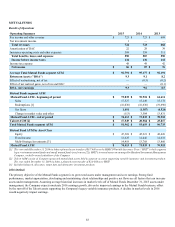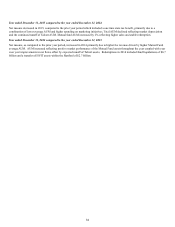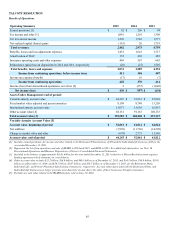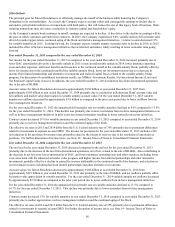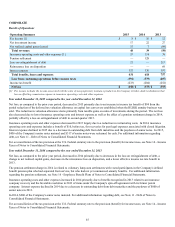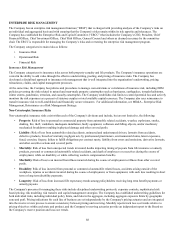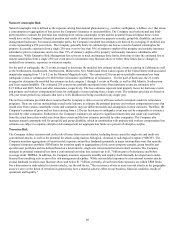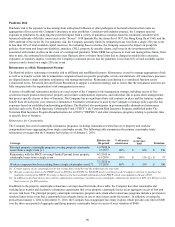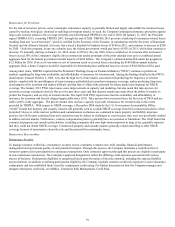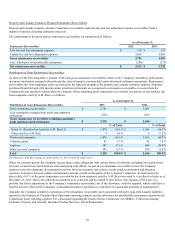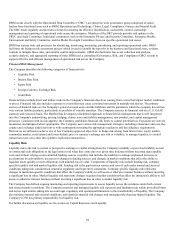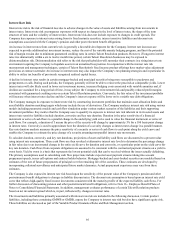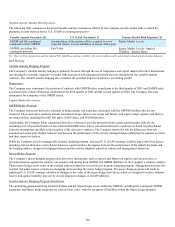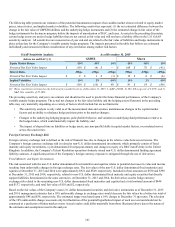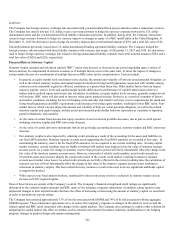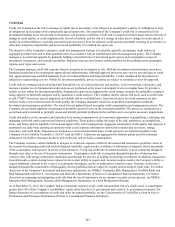The Hartford 2015 Annual Report Download - page 93
Download and view the complete annual report
Please find page 93 of the 2015 The Hartford annual report below. You can navigate through the pages in the report by either clicking on the pages listed below, or by using the keyword search tool below to find specific information within the annual report.
93
Life Insurance Product Reinsurance Recoverables
Life insurance product reinsurance recoverables represent future policy benefits and unpaid loss and loss adjustment expenses and other
policyholder funds and benefits payable that are recoverable from a number of reinsurers.
The components of the gross and net reinsurance recoverables are as follows:
As of December 31,
Reinsurance Recoverables 2015 2014
Future policy benefits and unpaid loss and loss adjustment expenses and
other policyholder funds and benefits payable 20,674 20,190
Gross reinsurance recoverables $ 20,674 $ 20,190
Less: Allowance for uncollectible reinsurance [1] — —
Net reinsurance recoverables $ 20,674 $ 20,190
[1] No allowance for uncollectible reinsurance is required as of December 31, 2015 and December 31, 2014
As of December 31, 2015, the Company has reinsurance recoverables from MassMutual and Prudential of $8.6 billion and $10.8 billion,
respectively. As of December 31, 2014 the Company had reinsurance recoverables from MassMutual and Prudential of $8.6 billion and
$10.4 billion, respectively. The Company's obligations to its direct policyholders that have been reinsured to Mass Mutual and Prudential
are secured by invested assets held in trust. Net of invested assets held in trust, as of December 31, 2015, the Company has no
reinsurance-related concentrations of credit risk greater than 10% of the Company’s consolidated stockholders’ equity.
Guaranty Funds and Other Insurance-related Assessments
As part of its risk management strategy, the Company regularly monitors the financial wherewithal of other insurers and, in particular,
activity by insurance regulators and various state guaranty associations relating to troubled insurers. In all states, insurers licensed to
transact certain classes of insurance are required to become members of a guaranty fund. In most states, in the event of the insolvency of
an insurer writing any such class of insurance in the state, members of the funds are assessed to pay certain claims of the insolvent
insurer. A particular state's fund assesses its members based on their respective written premiums in the state for the classes of insurance
in which the insolvent insurer was engaged. Assessments are generally limited for any year to one or two percent of the premiums
written per year depending on the state. The amount and timing of assessments related to past insolvencies is unpredictable.
Citizens Property Insurance Corporation in Florida (“Citizens”), a non-affiliate insurer, provides property insurance to Florida
homeowners and businesses that are unable to obtain insurance from other carriers, including for properties deemed to be “high risk.”
Citizens maintains a Personal Lines account, a Commercial Lines account and a High Risk account. If Citizens incurs a deficit in any of
these accounts, Citizens may impose a “regular assessment” on other insurance carriers in the state, such as the Company, to fund the
deficits, subject to certain restrictions and subject to approval by the Florida Office of Insurance Regulation. Carriers are then permitted
to surcharge policyholders to recover the assessments over the next few years. Citizens may also opt to finance a portion of the deficits
through issuing bonds and may impose “emergency assessments” on other insurance carriers to fund the bond repayments. Unlike with
regular assessments, however, insurance carriers only serve as a collection agent for emergency assessments and are not required to
remit surcharges for emergency assessments to Citizens until they collect surcharges from policyholders. Under U.S. GAAP, the
Company is required to accrue for regular assessments in the period the assessments become probable and estimable and the obligating
event has occurred. Surcharges to recover the amount of regular assessments may not be recorded as an asset until the related premium is
written. Emergency assessments that may be levied by Citizens are not recorded in the income statement.
Operational Risk Management
The Hartford has an Operational Risk Management (“ORM”) function whose responsibility is to provide a comprehensive and
enterprise-wide view of the Company's operational risk on an aggregate basis. The Company defines operational risk as the risk
of loss resulting from inadequate or failed internal processes, people and systems, or from external events. Operational risk is
inherent in our business and functional areas. It includes legal risk and considers reputational risk as an impact.
ORM is responsible for establishing, maintaining and communicating the framework, principles and guidelines of The Hartford's
operational risk management program. In addition, ORM also manages business continuity, model risk management, the ORM
system, and risk assessments. Responsibility for day-to-day management of operational risk lies within each business unit and
functional area.


